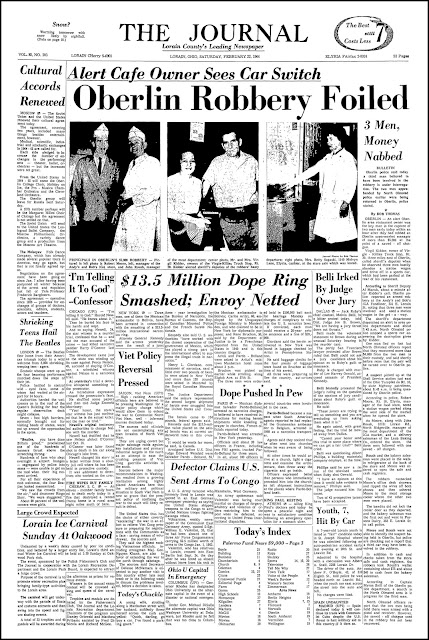Fifty or sixty years ago, newspapers seemed to always celebrate Leap Year by (sigh) trotting out the same gimmick each time: profiling someone on the front page born on that day who consequently only had a birthday every four years. They may still do this.
But every once in a while, the newspaper would remind the readers of some of the Leap Year Day traditions, such as women being allowed to propose marriage to men on that day.
Oberlin College had its own Leap Year Day tradition, as featured on the front page of the Feb. 29, 1936 Lorain Journal shown above. "As per an old Oberlin custom, Oberlin co-eds took full advantage today of "Leap Year Day," the article noted.
 |
| I'll bet those Oberlin College professors probably saw this movie when it came out a few years later! |
"Bright and early the leap year parade began in keeping with an Oberlin college tradition that women students shall "date" their instructors on quadrennial Feb. 29.
"Faculty wives, widowed while their husbands were taken to breakfast, lunch, tea, dinner and the theatre, planned their own "stags" party.
"A flurry at the faculty club and between-class conferences of co-eds and their professors suggested that some of the latter, whether gallant or graying, would have at least five "dates" between dawn and midnight.
"Undergraduate men growled because they were deprived of female company or waited with amusement for the evening. Blushing co-eds who asked their professors too late will escort their younger friends.
"Women students asked their usual escorts or their unrevealed heroes to a leap year dance tonight. They will call for the men, see them home and pay the bill."
It sounds like a pretty good racket for the professors (who I assume were all male). I wonder what their "widows" did at their stag parties?
Elsewhere on the same front page were a few other Leap Year Day stories.
One story was about Tom and Harry Wallace, twins from Elyria who were celebrating their sixth birthday. Tom was in the Navy and Harry was an employe of an Elyria bottling company.
The other article was fairly humorous and explained how unmarried girls took over all executive jobs for Leap Year Day in Aurora, Illinois. They apparently drew up a list of "Public Enemies" (eligible bachelors) and served notice that they would go to jail unless they proposed to a girl. They could weasel out of their sentence by paying their fine of 'one silk dress.'


















































